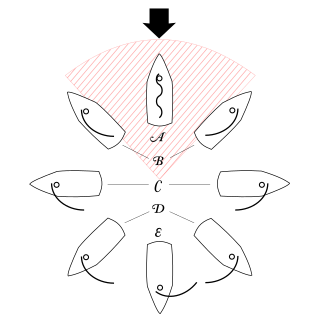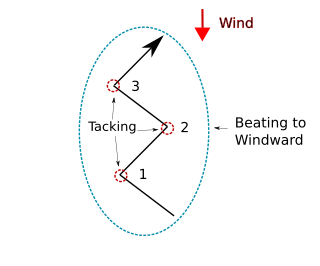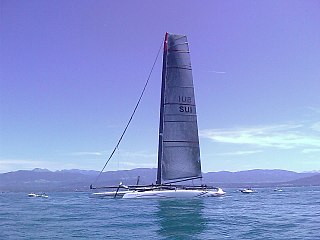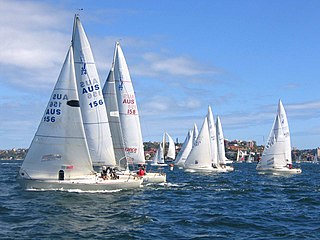Related Research Articles

Sailing employs the wind—acting on sails, wingsails or kites—to propel a craft on the surface of the water, on ice (iceboat) or on land over a chosen course, which is often part of a larger plan of navigation.
A match race is a race between two competitors, going head-to-head.
The weather gage is the advantageous position of a fighting sailing vessel relative to another. It is also known as "nautical gauge" as it is related to the sea shore. The concept is from the Age of Sail and is now antique. A ship at sea is said to possess the weather gage if it is in any position upwind of the other vessel. Proximity with the land, tidal and stream effects and wind variability due to geography may also come into play.

A point of sail is a sailing craft's direction of travel under sail in relation to the true wind direction over the surface.

A jibe (US) or gybe (Britain) is a sailing maneuver whereby a sailing vessel reaching downwind turns its stern through the wind, which then exerts its force from the opposite side of the vessel. Because the mainsail boom can swing across the cockpit quickly, jibes are potentially dangerous to person and rigging compared to tacking. Therefore, accidental jibes are to be avoided while the proper technique must be applied so as to control the maneuver. For square-rigged ships, this maneuver is called wearing ship.

Dinghy racing is a competitive sport using dinghies, which are small boats which may be rowboats, have an outboard motor, or be sailing dinghies. Dinghy racing has affected aspects of the modern sailing dinghy, including hull design, sail materials and sailplan, and techniques such as planing and trapezing.

A spinnaker is a sail designed specifically for sailing off the wind on courses between a reach to downwind. Spinnakers are constructed of lightweight fabric, usually nylon, and are often brightly colored. They may be designed to perform best as either a reaching or a running spinnaker, by the shaping of the panels and seams. They are attached at only three points and said to be flown.

Tacking or coming about is a sailing maneuver by which a sailing craft, whose next destination is into the wind, turns its bow toward and through the wind so that the direction from which the wind blows changes from one side of the boat to the other, allowing progress in the desired direction. Sailing vessels are unable to sail higher than a certain angle towards the wind, so "beating to windward" in a zig-zag fashion with a series of tacking maneuvers, allows a vessel to sail towards a destination that is closer to the wind that the vessel can sail directly.

In sailing, hiking is the action of moving the crew's body weight as far to windward (upwind) as possible, in order to decrease the extent the boat heels. By moving the crew's weight to windward, the moment of that force around the boat's center of buoyancy is increased. This opposes the heeling movement of the wind pushing sideways against the boat's sails. It is usually done by leaning over the edge of the boat as it heels. Some boats are fitted with equipment such as hiking straps and trapezes to make hiking more effective.
In a keel boat, a death roll is the act of broaching to windward, putting the spinnaker pole into the water and causing a crash-jibe of the boom and mainsail, which sweep across the deck and plunge down into the water. The death roll often results in the destruction of the spinnaker pole and sometimes even the dismasting of the boat. Serious injury to crew is possible due to the swift and uncontrolled action of the boom and associated gear sweeping across the boat and crashing to the (now) leeward side.
The Olympic triangle is a sailing course used in racing dinghies, particularly at major regattas like State, National and World Titles and was used at the Olympics.
Weather helm is the tendency of sailing vessels to turn towards the source of wind, creating an unbalanced helm that requires pulling the tiller to windward in order to counteract the effect.
The Men's RS:X was a sailing event on the Sailing at the 2008 Summer Olympics program in Qingdao International Sailing Centre. Eleven races were scheduled and completed. 35 sailors, on 35 boards, from 35 nations competed. Ten boards qualified for the medal race.

USA-17 is a sloop rigged racing trimaran built by the American sailing team BMW Oracle Racing to challenge for the 2010 America's Cup. Designed by VPLP Yacht Design with consultation from Franck Cammas and his Groupama multi-hull sailing team, BOR90 is very light for her size being constructed almost entirely out of carbon fiber and epoxy resin, and exhibits very high performance being able to sail at 2.0 to 2.5 times the true wind speed. From the actual performance of the boat during the 2010 America's Cup races, it can be seen that she could achieve a velocity made good upwind of over twice the wind speed and downwind of over 2.5 times the wind speed. She can apparently sail at 20 degrees off the apparent wind. The boat sails so fast downwind that the apparent wind she generates is only 5-6 degrees different from that when she is racing upwind; that is, the boat is always sailing upwind with respect to the apparent wind. An explanation of this phenomenon can be found in the article on sailing faster than the wind.

Alinghi 5 is a 90 ft (27 m) (LWL), 90 ft (27 m) beam sloop-rigged catamaran built by Alinghi for the 33rd America's Cup.

The 34th annual America's Cup was a series of yacht races held in San Francisco Bay in September 2013. The series was contested between the defender Oracle Team USA team representing the Golden Gate Yacht Club, and the challenger Emirates Team New Zealand representing the Royal New Zealand Yacht Squadron. Oracle Team USA defended the America's Cup by a score of 9 to 8 after winning eight consecutive races from Race 12 onwards, with Team New Zealand blowing a 8 to 1 lead. Team New Zealand won the right to challenge for the Cup by previously winning the 2013 Louis Vuitton Cup. The 34th America's Cup's race schedule was the longest ever, in terms of number of days and number of races, and the first since the 25th America's Cup to feature both teams in a match point situation. In addition for the first time since 1995, the format of the schedule changed so that the winner emerged from the best of 17 races.

The sport of sailing involves a variety of competitive sailing formats that are sanctioned through various sailing federations and yacht clubs. Racing disciplines include matches within a fleet of sailing craft, between a pair thereof or among teams. Additionally, there are specialized competitions that include setting speed records. Racing formats include both closed courses and point-to-point contests; they may be in sheltered waters, coast-wise or on the open ocean. Most competitions are held within defined classes or ratings that either entail one type of sailing craft to ensure a contest primarily of skill or rating the sailing craft to create classifications or handicaps.
Stars & Stripes 87 was the 12 Meter challenge boat sailed by Dennis Conner in his bid to reclaim the America's Cup from the Royal Perth Yacht Club of Australia in 1987.
The 1895 America's Cup occurred just two years after the 1893 America's Cup pitting the New York Yacht Club against the Royal Yacht Squadron. The 1895 race was between the Herreshoff designed sloop Defender owned by Charles Oliver Iselin, William Kissam Vanderbilt, and Edwin Dennison Morgan from the New York Yacht Club, and the Watson designed Valkyrie III owned by Lord Dunraven of the Royal Yacht Squadron.
The 1930 America's Cup was the 14th challenge for the Cup. It took place in Newport and consisted of a series of races between the defender Enterprise, entered by a syndicate of New York Yacht Club members headed by Winthrop Aldrich, and Shamrock V, the fifth in Sir Thomas Lipton's line of Cup challengers.
References
- 1 2 PHRF ratings and race courses Archived 2012-11-12 at the Wayback Machine Class rules and bylaws, Performance handicap racing fleet of Southern California , November 2009
- ↑ John Alonso Sailboat Racing -- Just the basics Slideshare, p. 22, Accessed Aug 9, 2013
- ↑ RG MEXORC -- All out, all week Latitude 38, Vol 394, April 2010, p. 121
- ↑ Stuart Streuli Bring Back the Random Leg! Sailingworld, March 31, 2011, Accessed Aug 9, 2013
- ↑ Random leg vs cruisers Yacht Racer's Resource Center, November 2011, Accessed Aug 9, 2013